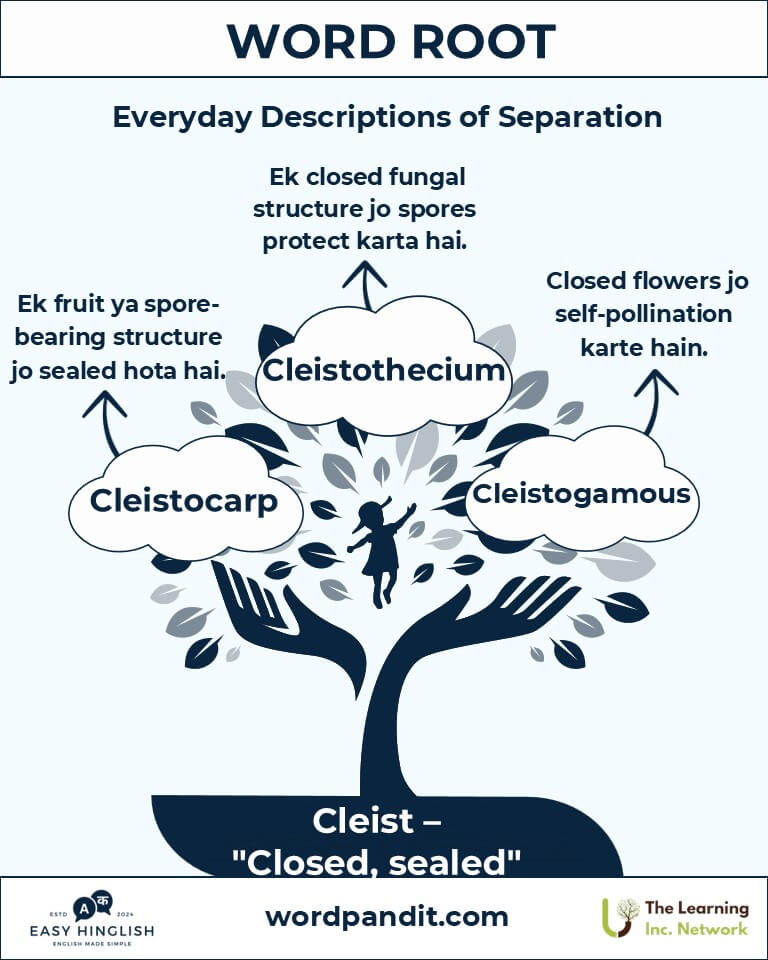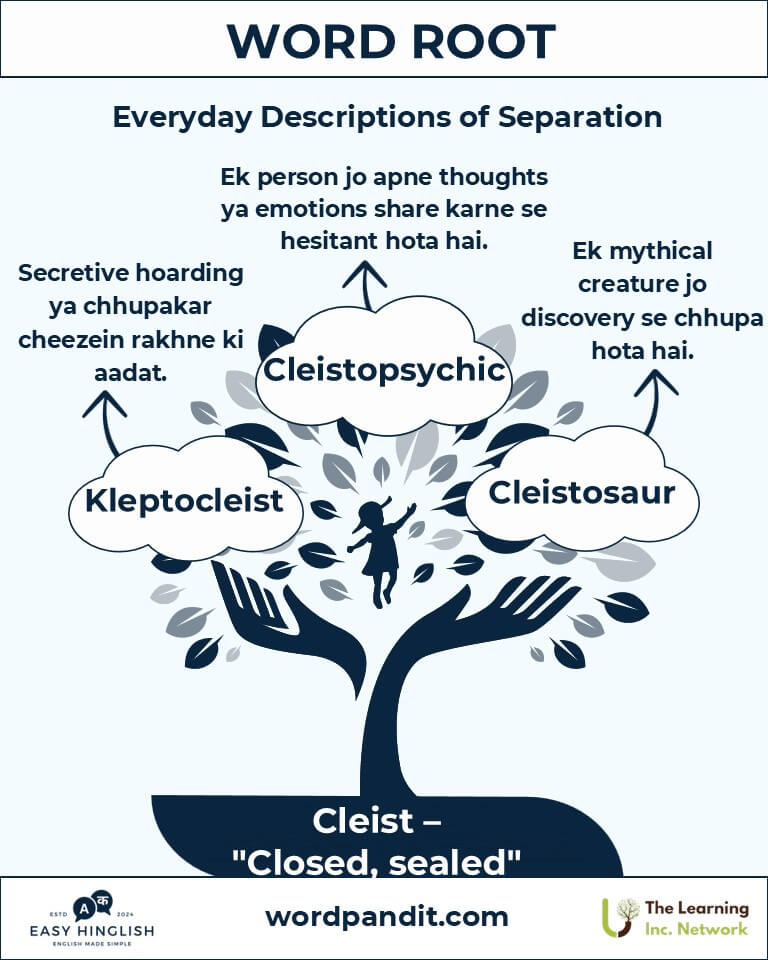Cleist: The Root of Closure and Secrecy in Language and Science
(Cleist: Band aur Rahasya ka Mool - क्लोजर और रहस्य का मूल)
Discover the enigmatic root "cleist," meaning "closed" (बंद), derived from Greek origins. Yeh root kai scientific terms aur concepts ka base hai jo secrecy (गोपनीयता), enclosure (संरक्षण), ya exclusivity (विशिष्टता) ko denote karta hai. Jaise "cleistogamous" flowers jo closed state mein self-pollinate karte hain, aur "cleistothecium," ek protective fungal structure. Aaiye, "cleist" aur iske biological, linguistic aur cultural applications ko explore karein.

Table of Contents
- Introduction: The Essence of Cleist
- Etymology and Historical Journey
- Mnemonic: Unlocking the Power of Cleist
- Common Cleist-Related Terms
- Cleist Through Time
- Cleist in Specialized Fields
- Illustrative Story: Cleist in Action
- Cultural Significance of Cleist
- The Cleist Family Tree
- FAQs About the Cleist Word Root
- Test Your Knowledge: Cleist Mastery Quiz
- Conclusion: The Living Legacy of Cleist
Introduction: The Essence of Cleist
(Cleist ka Mool Arth - Cleist का मूल अर्थ)
Sochiye ek aise phool ke baare mein jo kabhi nahi khilta, apne pollination ko ek cocoon (कोकून) mein protect karta hai, ya ek fungal spore jo ek secretive sac mein encased hai. Yeh hi "cleist" root ka essence hai, jo "closed" ka matlab rakhta hai aur Greek origin se aaya hai. Iska use biological sciences mein bahut common hai, jahan yeh hidden aur self-contained systems ko describe karta hai, jaise cleistogamous flowers aur cleistothecia structures.
Etymology and Historical Journey
(Cleist Root ka Itihaas - Cleist का इतिहास)
"Cleist" Greek word kleistos se derived hai, jiska matlab hai "closed" (बंद) ya "shut" (सील). Ancient botanical aur biological texts mein iska first use observe kiya gaya tha, jahaan secrecy aur self-containment emphasize kiya gaya tha. Over centuries, yeh root scientific Latin aur phir English mein include kiya gaya, aur iska core meaning closure aur isolation bana raha.
Mnemonic: Unlocking the Power of Cleist
(Mnemonic ke Zariye Cleist ko Yaad Rakhein - Cleist को याद रखने का तरीका)
Ek closed treasure chest imagine kariye, jiske andar ki cheezein hidden aur inaccessible hain. Yeh visual "cleist" root ke core meaning ko highlight karta hai—securely closed ya secret cheezein.
Mnemonic Device: "Cleist keeps it closed, from petals to treasure troves!"
Common Cleist-Related Terms
(Cleist ke Saath Jude Common Shabd - Cleist से जुड़े आम शब्द)
- Cleistogamous (kly-sto-guh-muhs - क्लिस्टोगैमस): Plants jo closed bud mein hi self-pollinate karte hain.
Example: "Violet cleistogamous flowers produce hote hain jab external pollinators ki kami ho." - Cleistothecium (kly-sto-thee-see-um - क्लिस्टोथीशियम): Ek closed fungal structure jo spores protect karta hai.
Example: "Cleistothecia fungal spores ko tab tak protect karte hain jab tak release conditions favorable na ho." - Kleptocleist (klep-toh-klyst - क्लेप्टोक्लिस्ट): Secretive hoarding ya chori ko describe karta hai.
Example: "Squirrel ka kleptocleist nature uske hidden stash of nuts ko ensure karta hai." - Cleistocarp (kly-stoh-karp - क्लिस्टोकार्प): Ek closed fruit ya spore-bearing structure.
Example: "Certain fungi cleistocarp develop karte hain taaki spores ko safeguard kiya ja sake." - Cleistosaur (kly-stoh-sawr - क्लिस्टोसॉर): Ek mythical ya hypothetical creature jo discovery se chhupa hota hai.
Example: "Cleistosaur ki legend humanity ke unseen fascination ko reflect karti hai."
Cleist Through Time
(Samay ke Saath Cleist ka Safar - समय के साथ Cleist का सफर)
Cleistogamy: A Botanical Secret
Historically, cleistogamy ka observation violets aur aise plants mein kiya gaya tha jo closed flowers mein self-pollination prefer karte hain. Yeh adaptation evolutionary advantage ko dikhata hai jab environment unfavorable hota hai.
Cleistothecia in Mycology
Cleistothecium ka prominence 19th century mein hua jab mycologists ne fungi ke protective reproductive structures study kiye. Is discovery ne nature ke intricate preservation aur dissemination strategies ko highlight kiya.
Cleist in Specialized Fields
(Vishesh Kshetron mein Cleist ka Mahatva - विशेष क्षेत्रों में Cleist का महत्व)
- Botany (वनस्पति विज्ञान): Cleistogamous plants limited resources mein self-sufficient reproduction dikhate hain.
Application: Cleistogamy ko samajhne se plant breeding aur conservation mein madad milti hai. - Mycology (कवक विज्ञान): Cleistothecium structures fungi identification aur spore dispersal samajhne ke liye important hote hain.
Application: Yeh fungal diseases ko control karne ke liye agricultural applications mein kaam aata hai. - Psychology (मानसिकता): Metaphorically, cleist root se inspired terms secretive ya introverted behaviors ko describe karte hain, jaise "cleistopsychic" (closed-mindedness).
Application: Yeh concepts human tendencies explore karte hain towards emotional aur intellectual enclosure.
Illustrative Story: Cleist in Action
(Cleist ki Ek Kahani - Cleist की एक कहानी)
Ek dense forest mein, Mira naam ki ek biologist violet species ke reproduction ko investigate kar rahi thi. Usne cleistogamous flowers observe kiye jo pollinators ki kami ke bawajood thrive karte hain. Wahiin, uska ek colleague fungi ke cleistothecia structures examine kar raha tha, jo spores ko safeguard karte hain. Dono ne nature ke ingenious closure aur secrecy wale protection methods ko discover kiya, jo "cleist" root ka perfect example hain.
Cultural Significance of Cleist
(Cleist ka Sanskritik Mahatva - Cleist का सांस्कृतिक महत्व)
"Cleist" root se jo "closure" ka concept symbolized hota hai, woh alag-alag cultures mein universal themes ko reflect karta hai, jaise secrecy, sanctity, aur self-sufficiency. Medieval Europe ke hermetically sealed alchemical flasks se lekar Eastern art ke "closed lotus" motifs tak, closure ki theme hamesha resonate karti hai.
The Cleist Family Tree
(Cleist Family ke Words - Cleist परिवार के शब्द)
- Claus- (Latin): Clause - Ek closed group of words within a sentence.
- Claustrophobia: Enclosed spaces ka fear.
- Clos- (Old French): Close - Shut ya secure karna.
- Closure: Close ya conclude karne ka act.
- Crypt- (Greek): Cryptic - Hidden ya mysterious.
- Crypt: Ek hidden chamber.

FAQs About the Cleist Word Root
(Cleist Root se Jude Prashn aur Uttar - Cleist से जुड़े सवाल और जवाब)
Q1: What does the root "Cleist" mean? ("Cleist" root का क्या अर्थ है?)
A: The root "Cleist" means "closed" (बंद) or "shut" (सील). It originates from the Greek word "kleistos" and is used to describe phenomena that are enclosed or secretive, such as cleistogamous flowers or cleistothecia in fungi. ("Cleist" का अर्थ है "बंद" या "सील।")
Q2: What are cleistogamous plants? (Cleistogamous पौधे क्या होते हैं?)
A: Cleistogamous plants produce flowers that self-pollinate in a closed state. This adaptation allows them to reproduce even in unfavorable environmental conditions, without relying on external pollinators. (Cleistogamous पौधे बंद अवस्था में self-pollinate करते हैं।)
Q3: What is a cleistothecium? (Cleistothecium क्या है?)
A: Cleistothecium is a closed fungal structure that protects spores. This casing prevents spore release until external conditions become favorable for growth. (Cleistothecium एक बंद कवकीय संरचना है जो spores को सुरक्षित रखता है।)
Q4: How is the "Cleist" root used metaphorically? ("Cleist" root को metaphorically कैसे उपयोग किया जाता है?)
A: Beyond biological fields, "Cleist" is used metaphorically to describe closed-off or secretive behaviors, such as "cleistopsychic," which refers to being emotionally guarded or hesitant to share thoughts. ("Cleist" metaphorically बंद या गुप्त व्यवहार को दर्शाता है।)
Q5: What is the origin of the Cleist root? (Cleist root की उत्पत्ति क्या है?)
A: The Cleist root comes from the Greek word "kleistos," meaning "closed." It entered English through scientific Latin and continues to describe phenomena of closure or secrecy. (Cleist root Greek शब्द "kleistos" से आया है।)
Test Your Knowledge:Cleist Mastery Quiz
(Cleist Quiz ke Zariye Apne Gyaan ko Test Karein - Cleist क्विज़)
1. Flowers that self-pollinate in a closed state are called? (वे फूल जो बंद अवस्था में self-pollinate करते हैं, उन्हें क्या कहते हैं?)
2. What does the Cleist root mean? ("Cleist" root का क्या अर्थ है?)
3. Which field studies Cleistothecia? (Cleistothecia का अध्ययन किस क्षेत्र में होता है?)
4. Cleistogamous flowers are advantageous because? (Cleistogamous फूल फायदेमंद क्यों होते हैं?)
5. Cleistothecium is a structure found in? (Cleistothecium किसमें पाया जाता है?)
Conclusion: The Living Legacy of Cleist
(Cleist ki Jeevant Virasat - Cleist की जीवंत विरासत)
Cleist root humein secrecy (गोपनीयता), protection (संरक्षण), aur self-sufficiency (आत्मनिर्भरता) ke concepts explore karne ka ek unique perspective deta hai. Nature ke ingenious adaptations se lekar cultural symbols tak, "cleist" humein dikhata hai ki closure aur boundaries kaise resilience aur mystery create karte hain.







